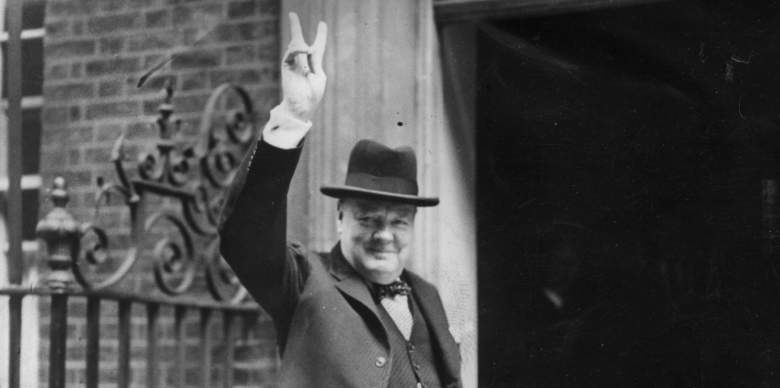
Getty Prime Minister Winston Churchill outside 10 Downing Street, gesturing his famous 'V for Victory' hand signal, June 1943.
A pivotal scene in the movie “Darkest Hour” shows Winston Churchill, played by Gary Oldman in an almost unrecognizable portrayal, journeying into the London Underground to chat with regular people in the subway.
To put it mildly, the group of average Londoners is shocked to see the prime minister, cigar and all, in their midst riding the tube. Churchill proceeds to query each of the working class Londoners about their attitude toward the British fight against Nazi Germany. To a one, they insist they would “never” give in, heralding his famous line (“We shall defend our island, whatever the cost may be, we shall fight on the beaches, we shall fight on the landing grounds, we shall fight in the fields and in the streets, we shall fight in the hills; we shall never surrender.”)
However, did the moment really occur? Did Winston Churchill really go into the subway to chat with average people as is shown in the Joe Wright-directed Hollywood film? No. The scene is not accurate.
According to Daily Variety, “It’s a scene that’s — transparently — too good to be true.” The New York Post also writes that the moving scene, unfortunately, did not really happen. “The subway scene — in which London commuters tell Churchill to never give up — is fictional,” notes The Post.

Gary Oldman and Randolph Churchill (R) attends the ‘Darkest hour’ UK premeire at Odeon Leicester Square on December 11, 2017 in London, England.
The Wrap asked the screenwriter for the movie, Anthony McCarten, whether the moment was based on historical realism, and he also said, no, not really. According to The Wrap, McCarten did not include the scene in a book he’s published about the same time period as the movie.
“McCarten admitted that no, it probably did not happen. But something like it might well have,” The Wrap reported, quoting the screenwriter as saying of Churchill that this was “the kind of thing he did right through the war. He would go AWOL, disappear and pop up somewhere in London with ordinary people, to find out what they were thinking. So that scene was drawn from deep research, but we have no record that it happened.”
In other words, the scene is not pulled from actual history, but it’s something the writers felt was in line with how the real Winston Churchill acted. The Wrap also noted that the distance he travels in the scene would only have taken two minutes today, hardly long enough to query all of the working class folks sitting on the train.
Darkest Hour is a companion piece to the Christopher Nolan film, Dunkirk, as it focuses on the same time frame, but this time from Churchill’s perspective, as the British Army was pushed to the beaches by the Germans and desperately needed what would end up being a miraculous rescue. The movie captures Churchill’s uncouth and complicated personality – his heavy drinking, his irascible personality – while revealing him to be the right man in charge at the exactly right time.
His stalwart belief that the British could persevere when the war, and all of Europe, seemed lost, stood in stark contrast to the Neville Chamberlains in his own government (including Chamberlain himself), who repeatedly pressured him to consider “peace talks” with the maniacal Hitler. We are left as viewers to wonder what would have become of Britain, and the world, had not a man with Churchill’s uncommon resolve and foresight been in charge. We are also left to wonder at the immersive performance by Oldman who disappears into jowls and bluster to deliver an uncanny portrayal of the prime minister whom he usually looks nothing like.